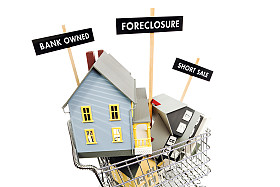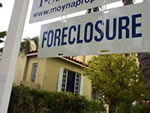Mortgage News
Mortgages
Sales Up, But Foreclosures Hit Record Highs
by Amy Lillard
May 28, 2009 - New reports this week on the housing market revealed some cause for optimism in a long-suffering sector. But data also showed some new problems facing more American homeowners.

Existing-home sales rose in March, up 2.9 percent to a seasonally adjusted annual rate of 4.68 million units, and slightly better than analysts expected, according to the National Association of Realtors. But despite the rise in sales, foreclosures are at an all time high, and are pushing down prices. Median home prices were down 15.4 percent in April compared to a year ago, the second-largest price decline since the group began collecting this data in 1968.
Distressed properties make up 45 percent of the market. Inventory increased nearly 9 percent last month, and at this current pace it would take 10.2 months to sell all of them.
Refinance at Today's Low Rates!Echoing the rest of the recession, certain areas of the country have been hit hardest by these price declines. In the West (including California and Nevada), sales in April outpaced the rest of the country with a 19.4 percent increase, but prices also fell the fastest by 21.8 percent.
Just how bad is the foreclosure force? A record number of borrowers are having trouble with their mortgages, and rising unemployment will continue to push more borrowers into foreclosure, according to the Mortgage Bankers Association. About 12.07 percent of mortgage loans were delinquent or in the foreclosure process during the first quarter of this year, the highest ever recorded by the survey that began in 1972. The figure also reflects an 8 percent increase compared to the first quarter of 2008.
Industry analysts say this jump isn't all that surprising. Many lenders held off on foreclosures during the loan modification discussions held by the Obama administration. Once the program was unveiled, moratoriums lifted and banks restarted foreclosure processing.
The recession has also acted to increase this foreclosure and delinquency rate. For the first time, prime loans, which are traditionally considered safe, represented the largest share of foreclosures instead of subprime loans. Overall, one in every eight Americans is now late on a payment or already in foreclosure, attributed to mounting job losses causing a wide spectrum of homeowners to fall behind.
For Further Reading:
http://www.washingtonpost.com/wp-dyn/content/article/2009/05/28/AR2009052801712.html?wprss=rss_business
http://www.bloomberg.com/apps/news?pid=20601087&sid=a2zH6o6F7Wuc&refer=home
Follow the link to continue reading the related articles:
Refinance Program Expands, Covers More Borrowers in Trouble
Foreclosure Prevention Plan Expands
More Mortgage Help on the Way?
Fannie Mae & Jumbo Mortgage Rates
Just One Click! = Current Rate Chart


